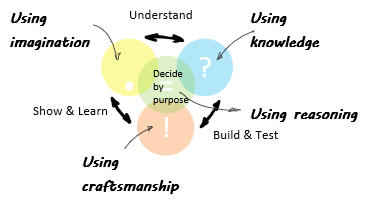Visioning-Development-Planning is the engine to speed up the development of systems. It connects people to the work, creating collaboration in trust in a learning environment.
With one visual anchor, people can manage each other and themselves in an agile way. It allows to take a quick project start with little information and resources available, and keep rolling. Participants can quickly anticipate from the early start and see how they contribute to the success of a project.
Visioning-Development-Planning will not conflict with installed structures, methods and tools. The visual anchor connects people to your methods and tools as a personalized framework, giving visibility to ‘what to use when’.
The method makes things understandable by visualizing situations as systems and models with properties, to organize continuous development in a smooth flow and cut the crap. Visual thinking allows to create with an open mind during conversations, and close with a written understanding in ‘only necessary’ documentation.
Creating systems with vision and strategy – understanding each other.
Visioning-Development-Planning is about ‘uncovering awareness of need‘ and guiding the process to fulfill it.

To achieve clarity, the desired outcome (‘What you want’) and the approach to achieve it (‘How to get it’) should be visualized as a system view encompassing both the current and future state. This perspective helps identify the relevant elements, relationships, functions, and properties by simply asking fundamental questions: What? Who? When? Why? How? How much? This approach makes complex systems understandable.
Each system created is connected to a larger system and adjacent systems. These different levels are interdependent and should be visualized. This holistic approach ensures that solutions fit seamlessly into broader contexts while addressing specific needs.
What’s under the hood.
Visioning-Development-Planning is all about making fast progress while finding meaning and having fun at work. At its core are four flexible stages, each guiding the creation and evolution cycle:
- [.] Make Your Point
- [?] Understand
- [!] Build Up
- [=] Decide by Purpose
These fragments follow a rhythm—a cycle tailored to the task at hand. There is no rigid starting point. The key is to start with a starting point and move through each phase until you reach a cycle of creation.
Rhythm:
Events can begin as frequently as manageable, in order to run a complete system translation cycle within a short time frame. While you can start anywhere, the preferred approach is to start with visioning (the path to innovation) or modeling (the path to creation).This flexibility allows to address pressing needs or dive into exploration, depending on priorities
Play:
Approach the process like a game. Define the sequence of steps ([.], [?], [!]), set clear objectives (=), and choose the tools and methods that suit the task. Regularly review and adjust as you learn from each step. This iterative approach keeps the work dynamic and responsive.
The fragments explained:


“make your point”
It is: a moment for using imagination without using knowledge, free from all judgment or constraints.
What you do is: visualizing what is in the head(s).
How: it is creating, a fast hand drawing picture with pen and paper.
Why: to capture individual and collaborative thinking.
Examples: a representation of a concept of your vision, a representation of each conversation/ communication, a representation of an observation.


“understand”
It is: a moment for using knowledge, exploring unknowns.
What you do is: visualizing as a system, how things look like- what things do- what processes are going on.
How: based on the hand drawn model, find knowns and unknowns in the system. Look from different viewpoints, through more knowledge lenses.
Why: to stimulate curiosity and research. Bring in expertise, professionalism and experience.
Examples: a representation of a concept of a system- product- service with its properties, a representation of the impact of each conversation/ communication, a representation of a process.


“build up”
It is: a moment for making things work, materializing, crafting and testing.
What you do is: creating tangible evidence, a model with properties.
How: fast prototyping and sampling to the final model in use. Acting in a possible reality.
Why: to learn by testing. Learn through experimentation and create actionable results.
Examples: paper prototypes, 3D prototypes, Virtual Reality prototype, test set up, pre-production samples.

“decide by purpose”
It is: a moment for reasoning—a purpose that drives movement to the next fragment and cycle. Align actions with a clear and focused purpose.
What you do is: creating purpose and building trust in collaboration with people.
How: reviewing and reflecting of whatever comes up, a team should ask “why we do this for, to achieve what”- “what can we do with what have now”.
Why: to be aware of purpose, avoid mistakes, appreciation outcome and learn.
Examples: short question & answer moment, give & take discussion, organized reviews, reflecting sessions, planning session, prioritizing, documenting.

Lessons learned.
Visioning-Development-Planning assist leaders and teams in creating great products. Many who contribute will remember the value of their work and the feeling of being appreciated for their efforts.
Read also the abstract: https://www.linkedin.com/pulse/combining-systems-thinking-design-patrik-marien.

